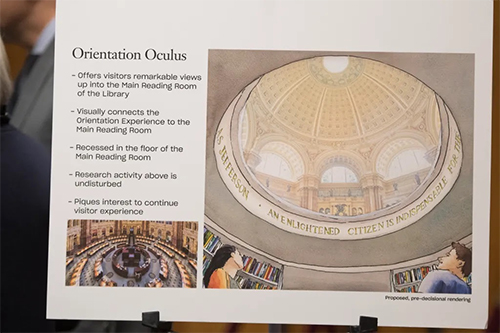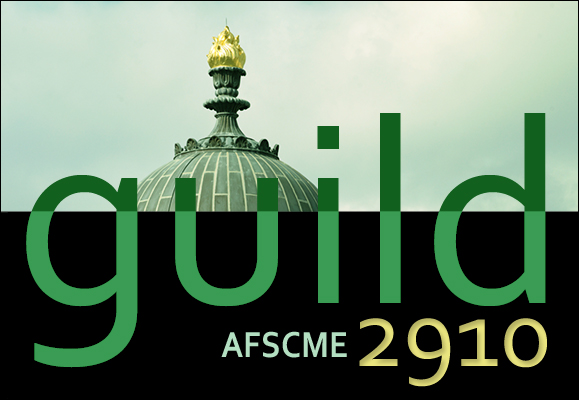It was almost four years ago when we first shared concerns on this website about potential changes to the Main Reading Room at the Library of Congress (here and here). Recent public attention prompts us to return to the issue of the Main Reading Room’s future configuration and uses. The Library’s current Visitor’s Experience Master Plan includes installing an “oculus” in the center of the Main Reading Room floor. This circular window would allow visitors to look up from an exhibition space below to view the interior of the Reading Room’s dome, displacing some or all of the room’s Center Desk as well as the Control Room just below. Such a change would disrupt the delivery of books to researchers while unnecessarily altering one of the nation’s most well-preserved, historic, and beautiful rooms. (In a hurry? Jump to the end of this post for key conclusions.)

In a memorable scene from the film National Treasure: Book of Secrets (2007), treasure hunter Ben Gates (played by Nicholas Cage) along with computer expert Riley Poole and document conservator Dr. Abigail Chase, have just discovered the “Book of Secrets”—a fictional diary passed down among U.S. presidents—in a locked box hidden in the stacks at the Library of Congress. From their location in an upper balcony near the dome of the Library’s famed Main Reading Room, the trio hears sirens approaching. While Ben stays behind to take photos, Abigail leads Riley at a run toward the center of the Reading Room floor and into the ring of the room’s massive Center Desk. They swiftly trace its inner circumference. With a glance at the nearby librarian engrossed in her work, Abigail opens and enters a well-concealed door and Riley follows. The next shot shows them racing down an ornate cast iron staircase into a hidden room that sits below the Reading Room, which allows them to escape—at least, for now.

This segment of National Treasure: Book of Secrets was filmed on location at the Library. Novelist Dan Brown also visited the Library frequently, and in his bestselling novel The Lost Symbol (2009), he too portrays the traversal of the Reading Room by a pair of characters involved in a different but equally compelling escape. “Into the octagonal console, down the steep set of stairs and into the unexpected space below, “Brown writes. “The heart of the Library’s circulation system.” He writes it just like that, in italics. Brown’s characters flee from the Jefferson Building to the Adams as stowaways in the Library’s book delivery conveyor-belt system, finding new uses for library-specific technology.
The hidden door, the staircase, the circular mahogany Center Desk with its outer ring and superintendent’s station towering above, the service room below: these were never meant as props for movies or backdrops for dramas—though their fame has invited such attention. These architectural features are instead working elements of the largest reading room of the largest library in the world, where they continue to serve functions first defined for this space when it opened in 1897. Herbert Small’s Handbook of the New Library of Congress, published that year, explains the Main Reading Room’s “relation to the rest of the building, and, especially, the reason for its central position.” For the ready availability of books in such a large library two things are needed, Small notes: an excellent catalog and easy access to the items. He continues:
This end is most easily attained by adopting what is called the ‘central system’ of library construction, which is the system followed in the Library of Congress…. The axes of the stacks are continued radii of the Rotunda, and, so far as the ground plan is concerned, the shortest way from any part of the cross to the Distributing Desk which the visitor sees below in the centre of the room is always along a straight line. This Distributing Desk, of course, being in the exact centre of everything, is the vital point, the kernel, of the whole arrangement. [emphasis added] (p. 58)
While the numerous other rooms comprising the perimeter of the building are important, he concludes:
It must steadily be borne in mind that the Rotunda and the stacks contain the real life of the institution. They are the only really essential and vital portion of the building; without them, there could hardly be a library; and by themselves they would be sufficient for almost every present need.” [emphasis added] (p. 58)
The room below the reading room has long been called the Control Room by LC staff, and was always an integral part of the building’s overall plan. This is the place where books from across the Library’s Capitol Hill campus and beyond are sorted and staged for delivery to researchers in multiple onsite locations, or back to their designated spots on the Library’s many hundreds of miles of shelves. A complex book delivery system once converged here, including pneumatic tubes now replaced by computers. Generations of conveyor belts (“a mechanical contrivance,” per Small) delivered books among the Jefferson stacks, and later to all three buildings, before they too were deemed obsolete. Today the room still fulfills its original function and purpose, while a dumbwaiter and hidden staircase still allow books and staff to travel up and down between the levels in a flash.
The quick, direct, and unobtrusive access provided by the Control Room’s placement has allowed Library staff to serve research patrons effectively for full on 125 years, even as technology has evolved, and even as the scope of collections and nature of research continues to change and grow. The great Center Desk and Control Room below have remained “the vital point, the kernel” and the “heart” of the Library of Congress’s first building since it opened.
* * * * *
All this may be about to change.
In late June, 2022, the DC Preservation League (DCPL) placed the Main Reading Room of the Library of Congress at the top of its Most Endangered Places list: Library of Congress Main Reading Room Tops List of Most Endangered Places in Washington, DC! As further explained on their website, “Beginning in 1996, the DC Preservation League has announced a list of Most Endangered Places to draw attention to Washington, DC’s, historically, culturally and architecturally significant places that may be threatened with ill-advised alteration or demolition through neglect or abandonment.”
This announcement by the DC Preservation League comes in response to planned changes by the Librarian of Congress and Architect of the Capitol—first announced in 2019, most recently reiterated in Spring of 2022—that will directly compromise the impeccably preserved historical and architectural integrity of the space by, in DCPL’s words, “adding a modern observation area that puts the needs of tourists and visitors above those of researchers who regularly use the Library.”
DCPL cites two planned alterations for its “most endangered” designation:
(1) The complete removal of the historic Center Desk, to be replaced by a circular window in the floor (an “oculus”) so that tourists below could look up to directly see the Reading Room’s dome.
(2) The repurposing of the Control Room now located directly below the Center Desk, from which books are staged and efficiently delivered to researchers, in order to create a “tourist-centered ‘Orientation Center’ with museum-type display cases containing Thomas Jefferson’s books.”
The League then emphasizes that these changes “would radically alter [the Main Reading Room’s] original architecture in terms of its view, its function, and its spatial relationships.”

(Tom Williams/CQ Roll Call via DC Preservation League)
DCPL bases its call to action on central principles from within the field of historic preservation that are used to determine the value of sites under threat, demonstrating succinctly how the Main Reading Room in its current, original form retains all elements of its historical and architectural integrity:
DCPL asserts that the Central Circulation Desk is not just a piece of furniture…. The Desk retains all seven aspects of integrity that preservation and design professionals look to when studying a proposed modification. These include location, setting, design, materials, workmanship, feeling, and association. Removal of the Desk would eviscerate the central character-defining feature and fundamentally alter the spatial relationship that was carefully crafted and designed for this important space. [emphasis added]
These seven fundamental aspects of integrity come directly from the criteria for inclusion on the National Register of Historic Places (see How to Apply the National Register Criteria for Evaluation, for example, including Section VIII: How to Evaluate the Integrity of a Property). The Library of Congress and other buildings that make up the Capitol Campus are explicitly exempted from inclusion on the National Register (see 54 U.S. Code § 307104). Yet, the Architect of the Capitol in its Order 37-1 (backup here) specifically states that “Because the National Historic Preservation Act of 1966 establishes the nation’s preservation policy… the Architect of the Capitol voluntarily follows its policies and standards.” (p. 15) The Library of Congress was designated a National Historic Landmark in December, 1965, and is listed as a DC historic landmark as well.
Following from the announcement by DCPL (including an opportunity to directly contact members of Congress posted July 14), The Washington Post published an article on Monday, July 18 titled “Preservationists Say Library of Congress Makeover Plan is ‘Vandalism'” by arts reporter Peggy McGlone. Later that same day, the Library released a blog post titled “A New Vision for an Inspiring Location” by April Slayton, LC Director of Communications. So far these have generated hundreds of comments as well as Tweets and Facebook posts—and nearly all the reactions have been unambiguously opposed to the plan.
* * * * *
The public is right. This plan to mutilate the reading room with an unneeded observation window onto a static mural erodes the integrity of an actual national treasure. It also displaces the ongoing work of library staff who strive to support the needs of researchers, just as they have for more than a century. The proposal has flown largely under the radar of public awareness for several years. Staff have had no real opportunities to share their views on this significant aspect of the Library’s Visitor Engagement Master Plan (VEMP), while the Library has remained largely silent as its plans have evolved through the stretch of the pandemic. Now the situation has changed, prompted by the attention of outside observers.
When we first encountered the proposed plan to remove the Center Desk in 2019, many staff members, including many within the Guild, assumed that the Architect of the Capitol would never approve this alteration because it so obviously disregards the ethics of historic preservation, as well as the specific laws they have voluntarily committed to uphold. But now it appears that plans to remove the Control Room along with part or all of the Center Desk are moving forward, and it is time for us to take a stand.
Guild Members are concerned about the future of library services at the Library of Congress. They are also concerned about preserving the history, culture, and physical integrity of this peerless institution, where so many have devoted their careers. The Guild does not disagree with the VEMP, or the desire to bring more visitors to the Library, or inspire them—including those who had perhaps not thought to directly use the Library’s collections, in addition to the next generation of readers. This all must be done, however, in a way that preserves, or even better foregrounds, the role of the Library of Congress as an incomparable library—starting with the integrity of its centerpiece, the magnificent Main Reading Room.
What you can do: We urge readers of this blog post to review the materials we’ve shared so far, spread the word, make your voice heard, and stay tuned for further updates in the news, from the Library, and from us. DCPL’s website is one great place to start. You may also contact the Guild directly about this issue at circleunbroken2910@gmail.com.
